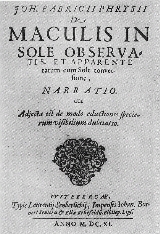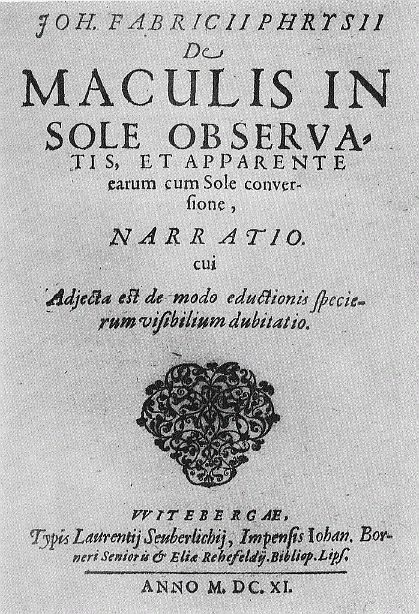
Johannes Fabricius
Encyclopedia
Johann Fabricius (8 January 1587 – 19 March 1616), eldest son of David Fabricius
(1564–1617), was a Frisian
/German
astronomer
and a discoverer of sunspot
s (in 1610), independently of Galileo Galilei
.
with telescopes that he and his father turned on the Sun
. Despite the difficulties of observing the sun directly, they noted the existence of sunspot
s, the first confirmed instance of their observation (though unclear statements in East Asian annals suggest that Chinese
astronomers may have discovered them with the naked eye previously, and Fabricius may have noticed them himself without a telescope a few years before). Johannes first observed a sunspot on February 27, 1611; in Wittenberg
that year he published the results of his observations in his 22 page pamphlet De Maculis in Sole observatis.... .
The pair soon used camera obscura
telescopy so as to save their eyes and get a better view of the solar disk, and observed that the spots moved. They would appear on the eastern edge of the disk, steadily move to the western edge, disappear, then reappear at the east again after the passage of the same amount of time that it had taken for it to cross the disk in the first place.
Copies of a map he made of Frisia in 1589 are also still extant. He is also name-checked in Jules Verne
's From the Earth to the Moon as someone who claimed to have seen lunar inhabitants through his telescope, though that particular fact is merely part of Verne's fiction. The large (90 kilometres or 55.9 mi) Fabricius crater
, on the Moon
's southern hemisphere, is named after his father, David Fabricius
.
He died in Marienhafe
, at the age of 29.
from 1603 until 1616.

wilfried schroeder, the discovery of sunspots, bremen 2009
David Fabricius
David Fabricius , was a German theologian who made two major discoveries in the early days of telescopic astronomy, jointly with his eldest son, Johannes Fabricius ....
(1564–1617), was a Frisian
Frisians
The Frisians are a Germanic ethnic group native to the coastal parts of the Netherlands and Germany. They are concentrated in the Dutch provinces of Friesland and Groningen and, in Germany, East Frisia and North Frisia, that was a part of Denmark until 1864. They inhabit an area known as Frisia...
/German
Germans
The Germans are a Germanic ethnic group native to Central Europe. The English term Germans has referred to the German-speaking population of the Holy Roman Empire since the Late Middle Ages....
astronomer
Astronomer
An astronomer is a scientist who studies celestial bodies such as planets, stars and galaxies.Historically, astronomy was more concerned with the classification and description of phenomena in the sky, while astrophysics attempted to explain these phenomena and the differences between them using...
and a discoverer of sunspot
Sunspot
Sunspots are temporary phenomena on the photosphere of the Sun that appear visibly as dark spots compared to surrounding regions. They are caused by intense magnetic activity, which inhibits convection by an effect comparable to the eddy current brake, forming areas of reduced surface temperature....
s (in 1610), independently of Galileo Galilei
Galileo Galilei
Galileo Galilei , was an Italian physicist, mathematician, astronomer, and philosopher who played a major role in the Scientific Revolution. His achievements include improvements to the telescope and consequent astronomical observations and support for Copernicanism...
.
Biography
Johannes was born in Resterhafe (East Friesland). He returned from university in the NetherlandsNetherlands
The Netherlands is a constituent country of the Kingdom of the Netherlands, located mainly in North-West Europe and with several islands in the Caribbean. Mainland Netherlands borders the North Sea to the north and west, Belgium to the south, and Germany to the east, and shares maritime borders...
with telescopes that he and his father turned on the Sun
Sun
The Sun is the star at the center of the Solar System. It is almost perfectly spherical and consists of hot plasma interwoven with magnetic fields...
. Despite the difficulties of observing the sun directly, they noted the existence of sunspot
Sunspot
Sunspots are temporary phenomena on the photosphere of the Sun that appear visibly as dark spots compared to surrounding regions. They are caused by intense magnetic activity, which inhibits convection by an effect comparable to the eddy current brake, forming areas of reduced surface temperature....
s, the first confirmed instance of their observation (though unclear statements in East Asian annals suggest that Chinese
Chinese people
The term Chinese people may refer to any of the following:*People with Han Chinese ethnicity ....
astronomers may have discovered them with the naked eye previously, and Fabricius may have noticed them himself without a telescope a few years before). Johannes first observed a sunspot on February 27, 1611; in Wittenberg
Wittenberg
Wittenberg, officially Lutherstadt Wittenberg, is a city in Germany in the Bundesland Saxony-Anhalt, on the river Elbe. It has a population of about 50,000....
that year he published the results of his observations in his 22 page pamphlet De Maculis in Sole observatis.... .
The pair soon used camera obscura
Camera obscura
The camera obscura is an optical device that projects an image of its surroundings on a screen. It is used in drawing and for entertainment, and was one of the inventions that led to photography. The device consists of a box or room with a hole in one side...
telescopy so as to save their eyes and get a better view of the solar disk, and observed that the spots moved. They would appear on the eastern edge of the disk, steadily move to the western edge, disappear, then reappear at the east again after the passage of the same amount of time that it had taken for it to cross the disk in the first place.
Copies of a map he made of Frisia in 1589 are also still extant. He is also name-checked in Jules Verne
Jules Verne
Jules Gabriel Verne was a French author who pioneered the science fiction genre. He is best known for his novels Twenty Thousand Leagues Under the Sea , A Journey to the Center of the Earth , and Around the World in Eighty Days...
's From the Earth to the Moon as someone who claimed to have seen lunar inhabitants through his telescope, though that particular fact is merely part of Verne's fiction. The large (90 kilometres or 55.9 mi) Fabricius crater
Fabricius (crater)
Fabricus is a lunar impact crater that is located within the northeast part of the walled plain Janssen. Attached to the north-northwest rim is the slightly larger cater Metius. Fabricius has multiple central peaks that rise to 0.8 km, with a rugged rise to the northwest running north–south. The...
, on the Moon
Moon
The Moon is Earth's only known natural satellite,There are a number of near-Earth asteroids including 3753 Cruithne that are co-orbital with Earth: their orbits bring them close to Earth for periods of time but then alter in the long term . These are quasi-satellites and not true moons. For more...
's southern hemisphere, is named after his father, David Fabricius
David Fabricius
David Fabricius , was a German theologian who made two major discoveries in the early days of telescopic astronomy, jointly with his eldest son, Johannes Fabricius ....
.
He died in Marienhafe
Marienhafe
Marienhafe is a municipality in the district of Aurich, in Lower Saxony, Germany....
, at the age of 29.
Legacy
In 1895, a monument was erected to his memory in the churchyard at Osteel, where he had been pastorPastor
The word pastor usually refers to an ordained leader of a Christian congregation. When used as an ecclesiastical styling or title, this role may be abbreviated to "Pr." or often "Ps"....
from 1603 until 1616.
Work

- Joh. Fabricii Phrysii De Maculis in Sole observatis, et apparente earum cum Sole conversione, Narratio, etc. Witebergae, Anno M.DC.XI. (year 1611).
Literature
- Gerhard Berthold: Der Magister Johann Fabricius und die Sonnenflecken, nebst einem Excurs über David Fabricius (Magister Johann Fabricius and Sunspots, together with a Digression on David Fabricius), Leipzig, 1894.
- L. Häpke: "Fabricius und die Entdeckung der Sonnenflecken" ("Fabricius and the Discovery of Sunspots") in: Abhandlungen des naturwissenschaftlichen Vereins zu Bremen, 10, 1888, pp. 249-272.
- Bunte: "Über Johannes Fabricus, den Entdecker der Sonnenflecken" ("On Johannes Fabricius, the Discoverer of Sunspots") in: Jahrbuch der Ges. für bildende Kunst und vaterländ. Altertümer zu Emden 9, H. 1, 1890, pp. 59-77.
- Diedrich Wattenberg: David Fabricius. Der Astronom Ostfrieslands (David Fabricius. Astronomer of East Friesland), Berlin 1964.
- Fritz Krafft: in Walther Killy's Literaturlexikon: Autoren und Werke deutscher Sprache (Literature-Lexicon: Authors and Words of German Language), 15 volumes, Gütersloh; München: Bertelsmann-Lexikon-Verl. 1988-1991 (CD-ROM Berlin 1998 ISBN 3-932544-13-7), Vol. 3.
wilfried schroeder, the discovery of sunspots, bremen 2009
External links
- The Galileo Project — biography of David and Johannes Fabricius.
- Eintrag im Biographischen Lexikon für Ostfriesland

